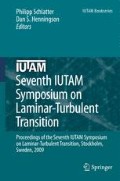Abstract
The application of control tools to fluid problems often requires model reduction to correctly capture the input-output behavior of the associated initial-value problem. In this study a model combining global modes (for the unstable subspace) and balanced modes (for the stable subspace) is considered.We show that this model succeeds in removing the global instability of the flow over an incompressible cavity. Comparison with other reduced models clearly demonstrates the superiority of this approach for control problems.
Access this chapter
Tax calculation will be finalised at checkout
Purchases are for personal use only
Preview
Unable to display preview. Download preview PDF.
References
E. Åkervik, J. Hoepffner, U. Ehrenstein and D. S. Henningson. Optimal growth, model reduction and control in a separated boundary-layer flow using global modes. J. Fluid Mech., 579, 305–314, 2007.
J. Delville, L. Cordier and J. P. Bonnet. Large-scale structure identification and control in turbulent shear flows. Flow Control: Fundamentals and Practice, 199–273, Springer Verlag, 1998.
M. Ilak and C. W. Rowley. Modeling of transitional channel flow using balanced proper orthogonal decomposition. Phys. Fluids, 20, 034103, 2008.
S. Bagheri, L. Brandt and D. S. Henningson. Input-output analysis, model reduction and control of the flat-plate boundary layer. J. Fluid Mech., 620, 263–298, 2009.
C.W. Rowley. Model reduction for fluids using balanced proper orthogonal decomposition. Int. J. Bifurc. Chaos, 15(3), 997–1013, 2005.
D. Sipp and A. Lebedev. Global stability of base and mean flows: a general approach and its applications to cylinder and open cavity flows. J. Fluid Mech., 593, 333–358, 2007.
K. Zhou, G. Salomon and E. Wu. Robust and Optimal Control. New Jersey: Prentice Hall, 2002.
A. Barbagallo, D. Sipp and P. J. Schmid. Closed loop control of an open cavity flow using reduced-order models. submitted to J. Fluid Mech.
Author information
Authors and Affiliations
Corresponding author
Editor information
Editors and Affiliations
Rights and permissions
Copyright information
© 2010 Springer Science+Business Media B.V.
About this paper
Cite this paper
Barbagallo, A., Sipp, D., Schmid, P.J. (2010). Closed-loop control of cavity flow using a reduced-order model based on balanced truncation. In: Schlatter, P., Henningson, D. (eds) Seventh IUTAM Symposium on Laminar-Turbulent Transition. IUTAM Bookseries, vol 18. Springer, Dordrecht. https://doi.org/10.1007/978-90-481-3723-7_74
Download citation
DOI: https://doi.org/10.1007/978-90-481-3723-7_74
Published:
Publisher Name: Springer, Dordrecht
Print ISBN: 978-90-481-3722-0
Online ISBN: 978-90-481-3723-7
eBook Packages: EngineeringEngineering (R0)

